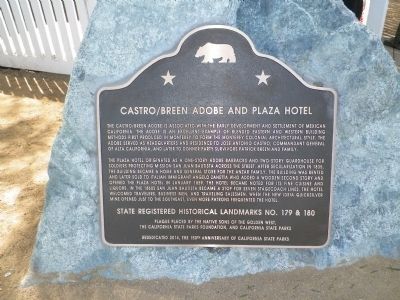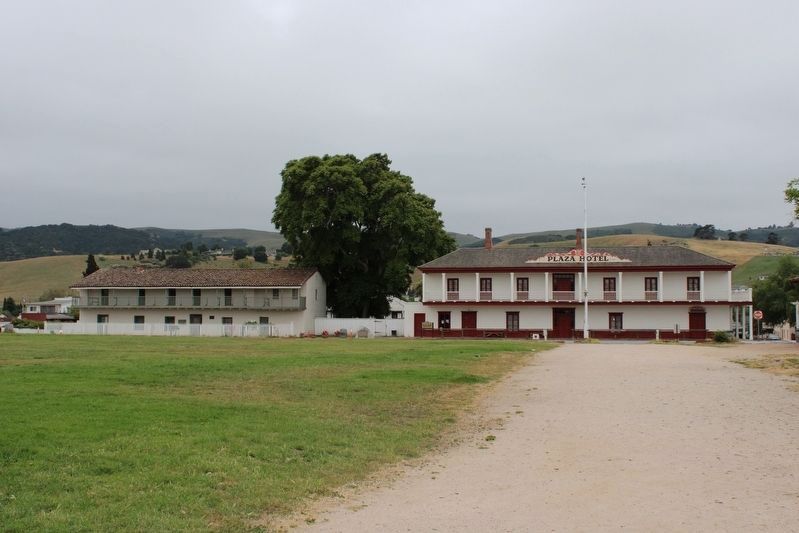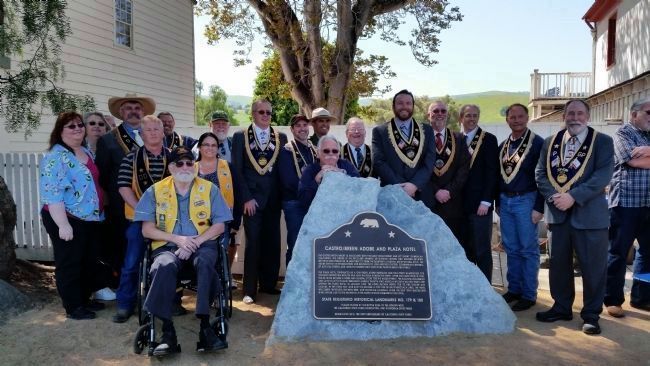San Juan Bautista in San Benito County, California — The American West (Pacific Coastal)
Castro/Breen Adobe and Plaza Hotel
The Plaza Hotel originated as a one-story adobe barracks and two-story guardhouse for soldiers protecting Mission San Juan Bautista across the street. After secularization in 1835, the building became a home and general store for the Anzar family. The building was rented and later sold to Italian immigrant Angelo Zanetta who added a wooden second story and opened the Plaza Hotel in January 1859. The hotel became noted for its fine cuisine and liquors. In the 1860s San Juan Bautista became a stop for seven stagecoach lines. The hotel welcomed travelers, business men, and traveling salesmen. When the New Idria quicksilver mine opened just to the southeast, even more patrons frequented the hotel.
Rededicated 2014, the 150th anniversary of California State Parks
Erected 2014 by California State Parks & Native Sons of the Golden West Historical Preservation Foundation. (Marker Number 179 & 180.)
Topics and series. This historical marker is listed in this topic list: Industry & Commerce. In addition, it is included in the California Historical Landmarks, and the Native Sons/Daughters of the Golden West series lists. A significant historical month for this entry is January 1859.
Location. 36° 50.694′ N, 121° 32.152′ W. Marker is in San Juan Bautista, California, in San Benito County. Marker is on 2nd Street, on the right when traveling east. The marker is between the Castro/Breen Adobe and the Plaza Hotel. Touch for map. Marker is in this post office area: San Juan Bautista CA 95045, United States of America. Touch for directions.
Other nearby markers. At least 8 other markers are within walking distance of this marker. San Juan Bautista Plaza Historic District (a few steps from this marker); Castro - Breen Adobe (within shouting distance of this marker); Progress Becomes History (within shouting distance of this marker); Town Jail (within shouting distance of this marker); The Amah Mutsun Garden (within shouting distance of this marker); Veterans of the World War (within shouting distance of this marker); El Camino Real (about 300 feet away, measured in a direct line); Vicky’s Cottage (about 300 feet away). Touch for a list and map of all markers in San Juan Bautista.
Regarding Castro/Breen Adobe and Plaza Hotel.
Castro Breen Adobe State Historical Landmark No.
179
Plaza Hotel State Historical Landmark No. 180
Plaque Rededication/Ribbon Cutting
Remarks: Amy H. Crain, State Historian II
Office of Historic Preservation, California State Parks
Saturday, April 4, 2015
The California Historical Landmarks Program is the oldest of California’s three registration programs, created in 1931. The very first Landmark, the Custom House, was registered in 1932.
The State Historical Resources Commission, originally the California Historical Landmarks Advisory Committee, reviews nominations, for final approval by the California State Parks Director. As part of the 150th anniversary of California State Parks in 2014, and in partnership with the Native Sons of the Golden West, the Office of Historic Preservation introduced the 150th Legacy Landmarks Project to designate new Landmarks, and update nominations and plaques at existing Landmarks, located in state parks. A usual year might include one or two California Historical Landmark nominations. In 2014 the Commission approved five new California Historical Landmarks and six updates to earlier Landmarks, bringing the total to 1,055 registered Landmarks. Nine of the eleven nominations, four new and five updates, were part of the Legacy Project.
In addition to the Castro-Breen Adobe and Plaza Hotel, this included updates to California Historical Landmarks Number
• 1, Custom House, in Monterey County
• 210, Camilo-Ynitia Adobe, in Marin County
• 368, Reid-Baldwin Adobe, in Los Angeles County, and
• 390, Bridgeport Historic District, in Nevada County
New California Historical Landmarks began with Number 1050, Crystal Cove Historic District in Orange County, followed by:
• 1051, Mountain Quarries Railroad Bridge, in El Dorado and Placer Counties
• 1052, Asilomar, in Monterey County
• 1053, Sierra Railway Shops, in Tuolumne County, and
• 1054, Tomo-Kahni, in Kern County.
The 150th Legacy Landmarks Project also funded a plaque for 993, Watts Towers in Los Angeles County.
A California Historical Landmark must meet at least one of the registration criteria. It must be:
• The first, last, only, or most significant historical property of its type in the region: Southern, Central, or Northern California; or
• Associated with an individual or group having a profound influence on the history of California; or
• Notable for its architecture or design.
The Castro House served as headquarters to José Castro, Commandant General of the Mexican Army in Alta California, and later was the residence of Donner Party survivor Patrick Breen. The nomination was updated to officially rename the landmark the Castro-Breen Adobe in recognition of the additional significance and interpretation of Breen family history.
The Plaza Hotel originated as a one-story adobe barracks for soldiers protecting the mission. The hotel opened by Angelo Zanetta in January 1859 remained open until it became part of California State Parks in 1933. The Plaza Hotel nomination was updated to complement its partner nomination for the Castro Breen Adobe.
Both buildings remain eligible as California Historical Landmarks as excellent examples of the blended Eastern and Western building methods first produced in Monterey to form the Monterey Colonial architectural style. Both properties are also associated with the early development and settlement of Mexican California, the California Mission system, and El Camino Real.
Credits. This page was last revised on January 23, 2024. It was originally submitted on April 8, 2015, by James King of San Miguel, California. This page has been viewed 655 times since then and 33 times this year. Photos: 1. submitted on April 8, 2015, by James King of San Miguel, California. 2. submitted on August 17, 2023, by Joseph Alvarado of Livermore, California. 3. submitted on April 8, 2015, by James King of San Miguel, California. • Andrew Ruppenstein was the editor who published this page.


